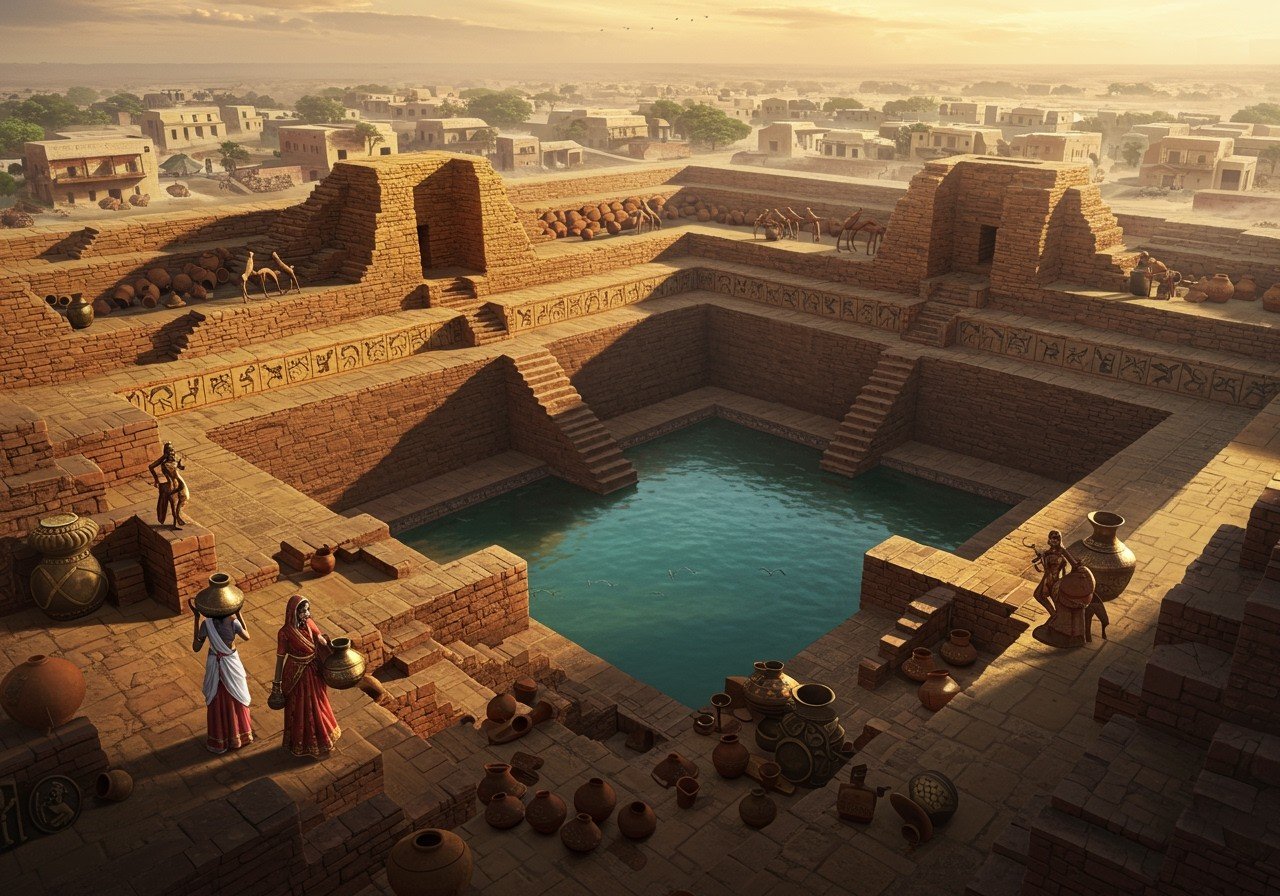
Mohenjo-daro, a jewel of the ancient Indus Valley Civilization, captivates with its remarkable architecture, sophisticated urban planning, and intriguing cultural practices. This blog delves into the city’s wonders, focusing on the iconic Great Bath, a testament to the ingenuity of the Harappan people.
The Indus Valley Civilization: A Glimpse into the Past
Flourishing around the third millennium BCE (circa 2500 BCE) in present-day Pakistan and northwest India, the Indus Valley Civilization stands out for its meticulously planned cities, advanced drainage systems, and standardized measurements. Key sites like Harappa, Dholavira, and Mohenjo-daro showcase the civilization’s remarkable urban development. A mysterious undeciphered script adds to the enigma of this ancient civilization, whose decline remains shrouded in uncertainty.
Mohenjo-daro: The Crown Jewel of the Indus Valley
Strategically situated along the Indus River, Mohenjo-daro, the largest city of the civilization, boasted a grid-pattern street layout and a remarkably advanced drainage system. The use of baked bricks in construction, a revolutionary technique for its time, highlights the city’s architectural prowess. Prominent public buildings like granaries, assembly halls, and the magnificent Great Bath underscore the city’s sophisticated urban design.
The Great Bath: An Architectural Marvel
The Great Bath, discovered in 1926, reigns as one of Mohenjo-daro’s most celebrated structures. Measuring approximately 12 meters long, 7 meters wide, and 2.4 meters deep, this meticulously crafted tank showcases exceptional brickwork and bitumen waterproofing. Surrounding colonnades and steps leading into the bath suggest its use for ritual bathing and social gatherings. Adjacent rooms likely served as changing areas and spaces for rituals, further emphasizing the bath’s cultural significance. The Great Bath stands as a testament to the advanced community life of the Indus Valley Civilization and is recognized as one of the earliest UNESCO World Heritage Sites in South Asia.
Urban Planning and Architecture: Innovations of Mohenjo-daro
Mohenjo-daro’s urban planning was truly exceptional. The city’s division into the Citadel and the Lower Town reflects a well-organized structure. A sophisticated drainage system with covered drains lining the main streets ensured sanitation and hygiene. Standardized brick sizes and uniform house construction point to a high degree of planning and organization. The presence of wells and advanced water management techniques further underscores the city’s ingenuity and foresight.
Cultural and Social Life in Mohenjo-daro
Artifacts unearthed in Mohenjo-daro, including pottery, tools, and toys, offer glimpses into the daily lives of its inhabitants. Evidence suggests trade connections with distant regions like Mesopotamia. Intricate seals, possibly used for trade or administration, highlight the city’s economic and social complexity. The inhabitants’ diet consisted of grains, fruits, and meats, indicating a diverse food culture. The social structure appears to have been relatively egalitarian.
The Enigmas and Legacy of Mohenjo-daro
Despite extensive research, many mysteries still surround Mohenjo-daro. The script on the seals remains undeciphered, leaving much of their purpose and meaning unknown. Theories about the city’s abandonment range from climate change and river shifts to invasions. Archaeologists continue to unravel the secrets of this ancient city, adding to our understanding of the Indus Valley Civilization.
Reflecting on Mohenjo-daro’s Wonders
Mohenjo-daro provides a captivating window into a sophisticated and advanced civilization. From the magnificent Great Bath to the city’s well-planned layout, Mohenjo-daro exemplifies remarkable achievements in engineering and architecture. The Indus Valley Civilization’s meticulous attention to detail and innovative solutions continue to inspire awe and admiration.
Preserving and studying Mohenjo-daro allows us to honor the ingenuity and resilience of our ancestors. Each new discovery adds a valuable piece to the puzzle of our shared history. Reflecting on these marvels deepens our appreciation for the traditions and advancements that have shaped our world. Exploring Mohenjo-daro is not just a journey into the past; it’s a connection with our heritage and a source of inspiration for the future. Let us cherish and protect these wonders, ensuring they continue to enlighten and inspire generations to come.
FAQs: Delving Deeper into Mohenjo-daro
What makes the Great Bath so remarkable? The Great Bath’s size, sophisticated construction, and potential use for ritual purposes make it a standout structure in Mohenjo-daro.
Why is Mohenjo-daro considered a significant city? As one of the largest cities of the Indus Valley Civilization, Mohenjo-daro showcases advanced urban planning, architecture, and a complex social structure.
How Poojn.in Connects You with Ancient Traditions
Poojn.in bridges the gap between ancient traditions and modern spiritual practices. Just as the Great Bath in Mohenjo-daro highlighted the importance of ritual purification, Poojn.in offers a curated collection of items to support your spiritual practices. We understand the significance of connecting with your heritage and offer a convenient way to incorporate traditional elements into your modern life.
- Pure copper and brass vessels: Ideal for water offerings and maintaining ritual purity, echoing the practices of ancient civilizations. Explore our collection of copper and brass items.
- Traditional clay lamps (diyas): Illuminate your sacred space with the warm glow of diyas, symbolizing the dispelling of darkness and ignorance. Find authentic diyas at Poojn.in.
Poojn.in delivers these sacred items across India, making it easier than ever to connect with the rich spiritual heritage of ancient civilizations like Mohenjo-daro.


